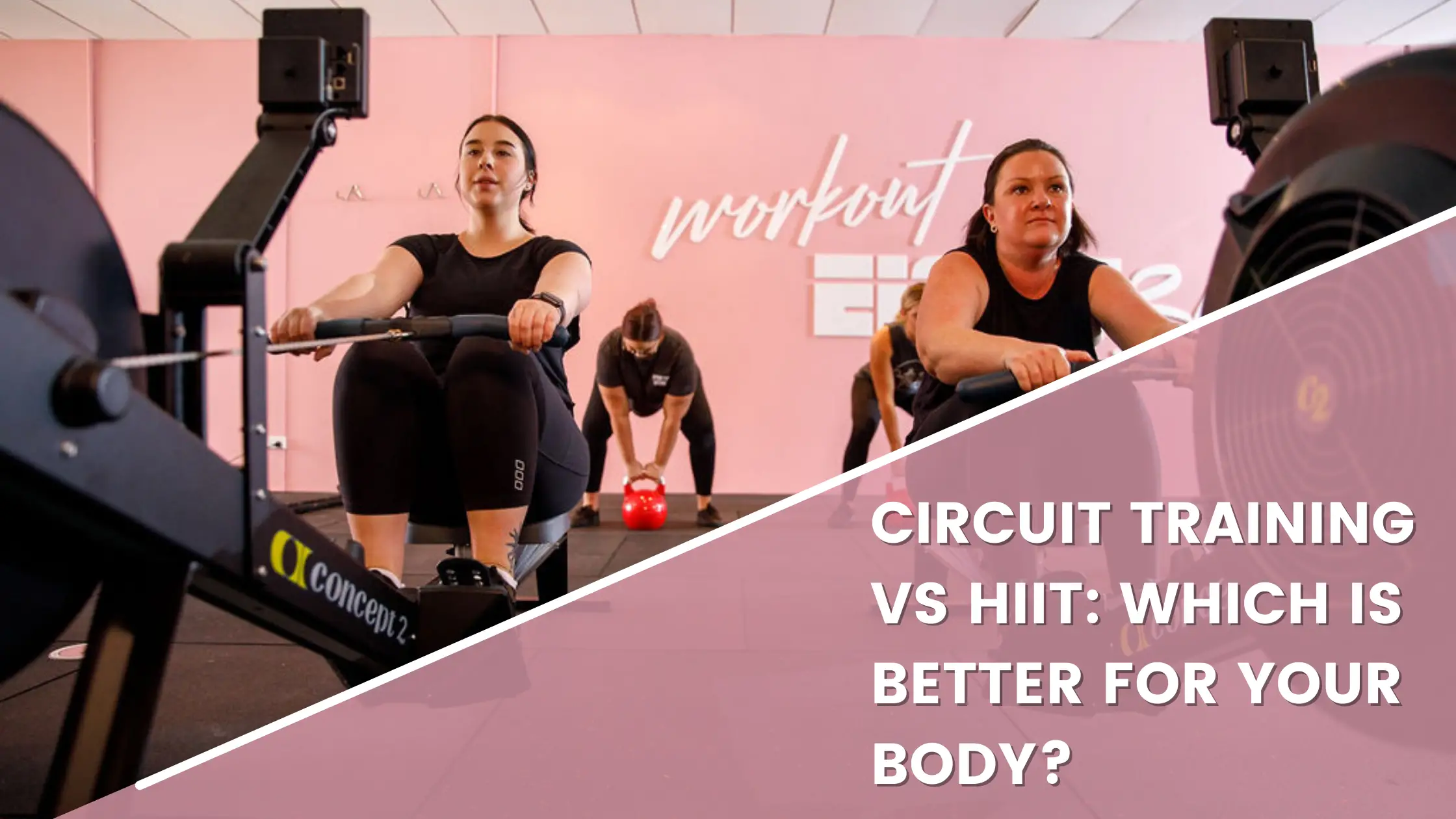Everyone exercises for different reasons, and with so many training options available, it can be confusing to find the training method that suits your goals. If you’re looking for recommendations on what workouts you should try, you will find that circuit training and high-intensity interval training (HIIT) are two of the most popular suggestions. But which one is better for your body and goals?
Circuit training is a fast-paced training style that combines a sequence of at least six different exercises or stations performed in rotation. Circuit training aims to get your heart rate up, you must continue to the next station with minimal to no rest. On the other hand, HIIT involves alternating short but high-intensity workouts with periods of complete rest or low-intensity recovery exercises.
Both circuit training and HIIT offer many benefits for the mind and body! But before choosing one over the other, it helps to understand the benefits of each exercise to see if they align with your health and fitness goals.
This article will take a closer look at circuit training and HIIT, the similarities they share, and what makes them different from each other.
Are Circuit Training & HIIT the Same Thing?
Circuit training and HIIT are not the same. To help you understand what these two training methods entail and how they differ, let’s deep dive into the main characteristics of each one.
What is Circuit Training?
Circuit training is a long-time favourite among gym-goers. Its roots can be traced back to the 1950s when R.E. Morgan and G.T. Anderson developed this training style to allow people to perform exercises of varying intensity levels in a fun group setting.
Circuit training involves a series of movements and a mix of different workouts that each focus on a particular muscle group. Each exercise in the circuit is done within an allocated duration, lasting for at least 30 seconds and up to a minute. When the time elapses or after completing the repetitions, a rest period will follow. During this phase, movement may be limited or stopped altogether.
Circuit training sessions usually last 35 to 45 minutes, rotating up to 10 exercises three or four times. Rest periods typically run for a minute after each round. But if you’re just trying it out as a beginner, you can begin with 10-minute sessions.
Many fitness coaches use circuit training to help develop cardiovascular health and build muscle strength. If increasing stamina and endurance is your goal, circuit training can be a great addition to your workout routine. A circuit training routine can also include aerobic exercises that can help you to burn calories quickly. If you want to strengthen your muscles, you can add resistance exercises to the circuit as well.
An excellent benefit of circuit training is that you can easily customise your workout routine by adding new stations or changing the order of movements. You can also increase the intensity of exercises if you want to challenge yourself more. If you exercise in a gym or have fitness equipment at home, you can incorporate different gym equipment like a treadmill or stationary bike into your routine. You can also use fitness tools like free weights and resistance bands to add variety to your drills.
What is HIIT?
A HIIT workout combines high-intensity exercise with less intense activity and a fixed rest period. This sequence is repeated until a specific time limit is reached. For example, a beginner HIIT session may involve sprinting for 30 seconds, then stopping or walking for a minute and a half to allow your body to recover. You continue this routine for a predetermined period.
Because HIIT sessions are very physically challenging in nature, they tend to be shorter in duration. For seasoned athletes or anyone who has been exercising regularly, 20 minutes of high-intensity interval training can deliver the most benefit for your body. However, for beginners, the recommended duration for each HIIT session is about 10 minutes.
The alternating periods of high-intensity and low-intensity or recovery periods make HIIT an excellent option for increasing heart health. Additionally, HIIT is effective if you’re trying to lose weight, tone your muscles, or improve your metabolism.
HIIT routines can be done without using complex exercise equipment. Exercises like running, jumping lunges, high knees or anything that will increase your heart rate will do. However, if you prefer exercising with gym equipment, you can use cardio equipment like a treadmill, rowing machine, or spin bike.
What are the Similarities Between HIIT & Circuit Training?
Circuit training and HIIT are similar in many ways, so it can be easy to confuse them. Because HIIT and circuit training involve intense activities that can be completed in a short duration, both are efficient at boosting cardiovascular health.
These fitness training methods are also both customisable, allowing you to choose the exercises to integrate into your routine according to your comfort level. You can reap the benefits of both forms of fitness training with or without using any gym machinery or fitness accessories.
Both HIIT and circuit training are also time-efficient. You can complete workout sessions in less than 30 minutes while reaping the same benefits from working out for an hour and a half in a different format. With either HIIT or circuit training in your workout plan, not only can you allot more time for other activities after a session, but you can also reach your fitness goals faster.
You won’t get bored with your routine because of the variety of exercises you can include in a HIIT or circuit training session. Rather than skipping your workouts, you’ll feel more motivated to train because these sessions will be fun and engaging.
Another similarity that HIIT and circuit training share is that you can perform either method indoors or outdoors. So, if you don’t want to be confined in a room, you can easily take your workout sessions outside.
What is the Difference Between Circuit Training & HIIT?
The main difference between circuit training and HIIT is the intensity of the workouts involved. In a circuit training session, exercises target different muscle areas. You also have the flexibility to adjust the intensity of your exercises and the period of rest. This makes circuit training a better option if you want to build muscle strength.
Meanwhile, the short bursts of high-intensity exercises in a HIIT session will get your heart beating at a faster rate, making HIIT a great choice for improving cardio health and speeding up weight loss.
Circuit Training vs HIIT: Which is More Effective?
Circuit Training vs for Fat Loss & Weight Loss
Both HIIT and circuit training are efficient in achieving weight loss and fat loss. However, HIIT can be more effective in speeding up weight loss because the high-energy exercises take your heart and metabolic rates up a notch during each session. As a result, your body continues to burn fat during your resting phases. Your metabolic rate is also sustained for hours after a HIIT session, which helps your body to drop weight more quickly.
Circuit Training vs HIIT: Calories Burned
You’ll burn calories whether you engage in HIIT or circuit training. However, if you’re looking for a faster way to burn energy, HIIT is more up your alley. The high-intensity activities in a HIIT routine require your body to use a greater amount of energy, which is necessary to burn calories at maximum effectiveness.
Circuit Training vs HIIT for Building Muscle
Circuit training is better suited for building muscle strength and endurance than high-intensity interval training. Circuit training allows you to train different muscle areas at each station, so you’re actually getting a full-body workout.
For example, you can start the circuit with an upper-body exercise, then follow it with a lower-body station. The third station can then be another upper-body exercise. You can even opt to include a core and cardio workout as the fourth and fifth stations. You can follow this sequence for one session and then change up the stations and sequence for your next workout. You can also modify the number of reps you do at each station if you want to focus on a particular muscle group.
Circuit Training vs HIIT for Cardio Health
Both circuit training and HIIT can be effective for improving cardio health. In a HIIT session, you perform high-intensity exercises followed by low-intensity movements. This keeps your heart rate up during and even after a session.
Circuit-style training offers more flexibility in your workouts. You can either focus on muscle and core building or squeeze in a cardio station in the circuit if you also want to hit multiple goals in a single session.
Related Questions
What is the Difference Between HIIT and Regular Interval Training?
GHIIT is a cardiovascular training strategy where a high-intensity workout is followed by a recovery period of lower intensity activity. Meanwhile, regular interval training is a training method that involves combining high intensity, moderate intensity, and low-intensity exercises with periods of recovery. Hence, HIIT is a type of regular interval training.
What Are the Disadvantages of Circuit Training?
Body Combat is a workout design that combines steady-state and high-intensity exercises as a form of cardio peak training. It can be counted as high-inten
One disadvantage of circuit training is that moving from one station to another, particularly if pieces of gym equipment are involved, poses injury risks if not well-coordinated, especially in crowded group training classes.
Another issue is space. With at least five different stations in a circuit, you’ll need to have a wider space to effectively complete circuit training, whether you’re working out at a fitness facility or in your at-home gym.
Health experts recommend circuit training be done with rest days in between sessions. Otherwise, it may lead to overfatigue or overexertion of muscles.
Can HIIT Be Dangerous?
HIIT is an exciting workout option that can give you amazing results in a short time. But due to the intensity of movements required by the exercises, HIIT can be risky for people with heart conditions. It can also be dangerous for individuals recovering from injury or beginners whose muscles need some time to grow accustomed to the physical demands of the routine. In addition, doing HIIT workouts consecutively can lead to injury, burnout, or overtraining your body, so it’s important to ensure you’re physically able to train and that you match your exterion to your fitness level.
What is High-Intensity Circuit Training (HICT)?
High-intensity circuit training is the combination of high-intensity and low-intensity strength and cardio exercises in a workout. This style of fitness training lets you gain strength while burning calories.
Like HIIT, HICT increases the afterburn effect or is scientifically known as post-exercise oxygen consumption (EPOC). The afterburn effect typically lasts for 10 hours to three days after your workout session and causes your body to continue expending energy, hence burning the extra calories.
Disclaimer:
This article is published for general informational purposes only. It does not constitute medical advice and does not take into consideration your individual circumstances, medical conditions or abilities. Always consult a medical professional before beginning any program of exercise. A fitness industry professional can provide personalised advice to suit your needs.

